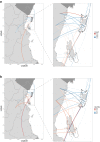Multiplexed ddPCR-amplicon sequencing reveals isolated Plasmodium falciparum populations amenable to local elimination in Zanzibar, Tanzania
- PMID: 37349311
- PMCID: PMC10287761
- DOI: 10.1038/s41467-023-39417-1
Multiplexed ddPCR-amplicon sequencing reveals isolated Plasmodium falciparum populations amenable to local elimination in Zanzibar, Tanzania
Abstract
Zanzibar has made significant progress toward malaria elimination, but recent stagnation requires novel approaches. We developed a highly multiplexed droplet digital PCR (ddPCR)-based amplicon sequencing method targeting 35 microhaplotypes and drug-resistance loci, and successfully sequenced 290 samples from five districts covering both main islands. Here, we elucidate fine-scale Plasmodium falciparum population structure and infer relatedness and connectivity of infections using an identity-by-descent (IBD) approach. Despite high genetic diversity, we observe pronounced fine-scale spatial and temporal parasite genetic structure. Clusters of near-clonal infections on Pemba indicate persistent local transmission with limited parasite importation, presenting an opportunity for local elimination efforts. Furthermore, we observe an admixed parasite population on Unguja and detect a substantial fraction (2.9%) of significantly related infection pairs between Zanzibar and the mainland, suggesting recent importation. Our study provides a high-resolution view of parasite genetic structure across the Zanzibar archipelago and provides actionable insights for prioritizing malaria elimination efforts.
© 2023. The Author(s).
Conflict of interest statement
The authors declare no competing interests.
Figures








Similar articles
-
Strong isolation by distance and evidence of population microstructure reflect ongoing Plasmodium falciparum transmission in Zanzibar.Elife. 2024 Jun 27;12:RP90173. doi: 10.7554/eLife.90173. Elife. 2024. PMID: 38935423 Free PMC article.
-
Falciparum malaria from coastal Tanzania and Zanzibar remains highly connected despite effective control efforts on the archipelago.Malar J. 2020 Jan 28;19(1):47. doi: 10.1186/s12936-020-3137-8. Malar J. 2020. PMID: 31992305 Free PMC article.
-
The use of mobile phone data for the estimation of the travel patterns and imported Plasmodium falciparum rates among Zanzibar residents.Malar J. 2009 Dec 10;8:287. doi: 10.1186/1475-2875-8-287. Malar J. 2009. PMID: 20003266 Free PMC article.
-
Strong isolation by distance and evidence of population microstructure reflect ongoing Plasmodium falciparum transmission in Zanzibar.medRxiv [Preprint]. 2024 Feb 13:2023.02.15.23285960. doi: 10.1101/2023.02.15.23285960. medRxiv. 2024. Update in: Elife. 2024 Jun 27;12:RP90173. doi: 10.7554/eLife.90173. PMID: 36865135 Free PMC article. Updated. Preprint.
-
Genetic structure and dynamics of Plasmodium falciparum infections in the Kilombero region of Tanzania.Trans R Soc Trop Med Hyg. 1999 Feb;93 Suppl 1:11-4. doi: 10.1016/s0035-9203(99)90321-8. Trans R Soc Trop Med Hyg. 1999. PMID: 10450420 Review.
Cited by
-
Risk of imported malaria infections in Zanzibar: a cross-sectional study.Infect Dis Poverty. 2023 Aug 28;12(1):80. doi: 10.1186/s40249-023-01129-5. Infect Dis Poverty. 2023. PMID: 37641152 Free PMC article.
-
Lower Microscopy Sensitivity with Decreasing Malaria Prevalence in the Urban Amazon Region, Brazil, 2018-2021.Emerg Infect Dis. 2024 Sep;30(9):1884-1894. doi: 10.3201/eid3009.240378. Emerg Infect Dis. 2024. PMID: 39174028 Free PMC article.
-
All-In-One OsciDrop Digital PCR System for Automated and Highly Multiplexed Molecular Diagnostics.Adv Sci (Weinh). 2024 Jun;11(21):e2309557. doi: 10.1002/advs.202309557. Epub 2024 Mar 22. Adv Sci (Weinh). 2024. PMID: 38516754 Free PMC article.
-
Sensitive and modular amplicon sequencing of Plasmodium falciparum diversity and resistance for research and public health.bioRxiv [Preprint]. 2025 Feb 19:2024.08.22.609145. doi: 10.1101/2024.08.22.609145. bioRxiv. 2025. Update in: Sci Rep. 2025 Mar 28;15(1):10737. doi: 10.1038/s41598-025-94716-5. PMID: 39229023 Free PMC article. Updated. Preprint.
-
Review of MrsFreqPhase methods: methods designed to estimate statistically malaria parasite multiplicity of infection, relatedness, frequency and phase.Malar J. 2024 Oct 15;23(1):308. doi: 10.1186/s12936-024-05119-2. Malar J. 2024. PMID: 39407242 Free PMC article. Review.
References
-
- World Health Organization. WHO Malaria Report 2022 (WHO, 2022).

